
"Operation Pillar of Defense has regained Israel its traditional spot in the caricature arena, after it lost the center stage to the Arab Spring," one prominent cartoonist, who asked to remain anonymous, told Ynet.
Related stories:
- Arab women highlight of grim year, columnist says
Caricatures blame Israel, US for incendiary film
Op-ed: Arab Spring's side effects
According to the artist, Arab caricaturists continue delineating the Palestinian-Israeli conflict not only because of its prominence in the Middle Eastern psyche but also because it keeps "regenerating," thus making for a bottomless supply of material.
"The conflict is visually-rich, which is inspiring for illustrators," he added.
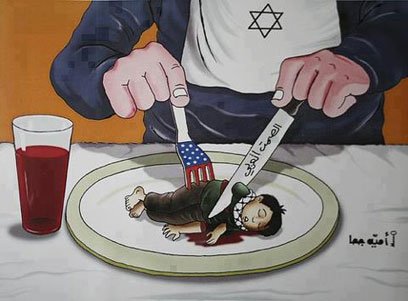
Cartoon published during Gaza hostilities. Caption on knife: Arab silence
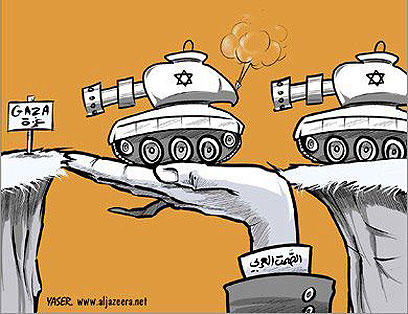
Yet again, Arab silence paving way for Israeli tanks
Nevertheless, the artist admitted the satirical sketches tend to be repetitive, noting that some cartoonists choose the tried-and-true subject by default when bashing Israel is easier than criticizing Arab regimes.
A young Kuwaiti caricaturist, Adel Al-Qallaf, echoed the sentiment.
While Israel doesn't make it into his own sketchbook too often, "every cartoonist needs to dabble in the issue," Qallaf said.
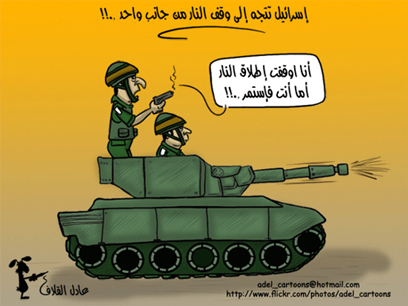
'Unilateral ceasefire.' Soldier: I'll hold fire, but you keep on shooting. Caricature by Adel Al-Qallaf
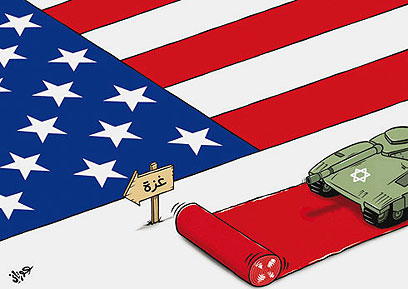
'To Gaza.' Cartoon depicting US support for Israeli strikes on Gaza during Operation Pillar of Defense
He took the opportunity to assert his own stand on the conflict, suggesting that the caricatures portend what's in store for the sides involved.
"Victory belongs to the righteous," he said. "The oppressor will realize this on the day that he hangs from the cartoonists' gallows."
Anti-Israel cartoons have been gracing the pages of Arab newspapers and magazines for several decades, their popularity spiking each time there is a game-changing event in the Israeli-Arab relations.
A famous caricature released in 1967, during the Six Day War, depicted Gamal Abdel Nasser, the president of Egypt at the time, kicking a man drawn in accordance with the anti-Semitic stereotype of Jews. Another image from the same era, featured in a Syrian paper, shows an armed Arab soldier threatening an Israeli who is running for his life, under the caption "Zionists go to hell."
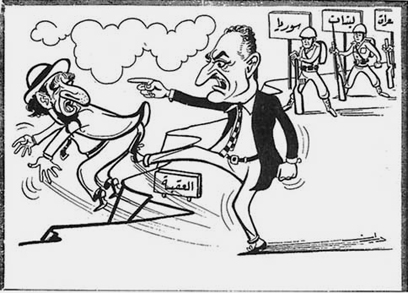
Nasser kicking Israel into the sea. 1967
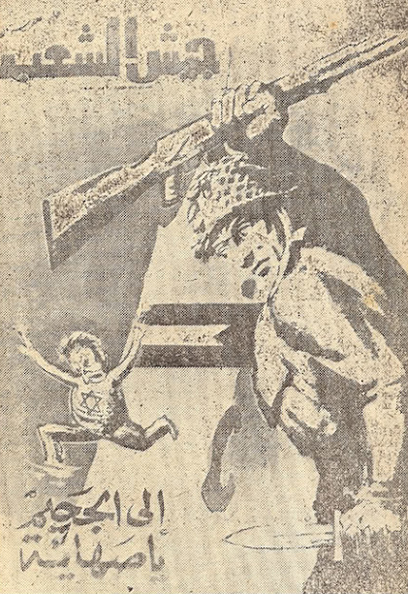
Arab soldier repeling 'Zionists' into the sea. Six Day War
Anti-Semitism is a familiar theme, but the aforementioned well-known cartoonist said his colleagues often use the offensive imagery unwitting of its origin and the weight it carries.
Arab cartoonists have "inherited" the anti-Jewish visual symbols from their predecessors, and as consequence, he said, "they express hostility towards Jews the same way it was demonstrated in the '40s and '50s without being aware of the (symbols') meaning."
On the other hand, he noted, the anti-Semitism charge sweepingly leveled against Arab illustrators often isn't warranted.
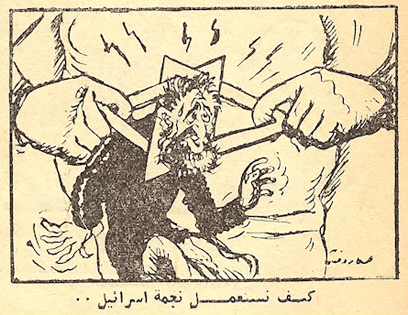
Caricaturists inherited anti-Semitic imagery.'67
"Derisive caricaturists across the globe can depict politicians as bloodsuckers," he said. "What makes it anti-Semitism when Netanyahu and Sharon are in the picture?"But with revolutions still playing out in Arab countries, the Jewish state isn't the only subject matter that the cartoonists are taking up. The protesters who took to the streets and demanded civil rights and freedom have, in varying degrees of success, gained political cartoonists some wiggle room to criticize Mideast regimes.
"One of the best things that happened during the Arab Spring is that all the barriers have been broken down," the artist asserted. "Less than two years ago, blasting Arab leaders could put your life in jeopardy. Today, caricaturists are trying to outdo each other by disparaging Arab leaders, sometimes of their own countries.

Iran fanning flames of Israel-Gaza conflict
"But the fear of being accused of denigrating the president or king still exists, and we hope that it will soon disappear."
He noted that some media outlets that are funded by Saudi Arabia and Qatar allow the editorial staff to mock leaders like Syria's Bashar Assad or Libya's late Muammar Gaddafi, but won't allow it to speak out against their own.
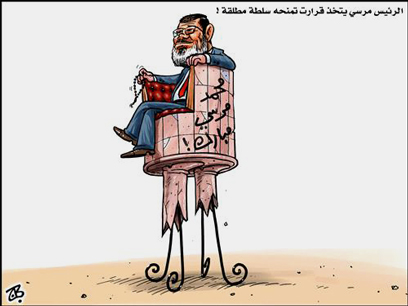
Egypt's Morsi in the ivory tower
"As a general rule the top figures in Arab countries aren't good sports and don't understand sarcasm, especially the devout religious ones who are unfortunately in power," the artist said. "Some believe that this whole caricature thing is forbidden by (Islamic law)."
Qallaf, the Kuwaiti cartoonist, said that people in his own line of work are on par with soldiers fighting for freedom.
"Caricatures in the Arab world are certainly the only weapon that can fight armies and tanks," he said. "The people need them to express themselves. The caricaturists have a prominent role in the current situation because their work deals with issues that many others cannot address.
"They do it bravely," he asserted. "They are the combat troops who fight with pencils."
- Receive Ynetnews updates
directly to your desktop















